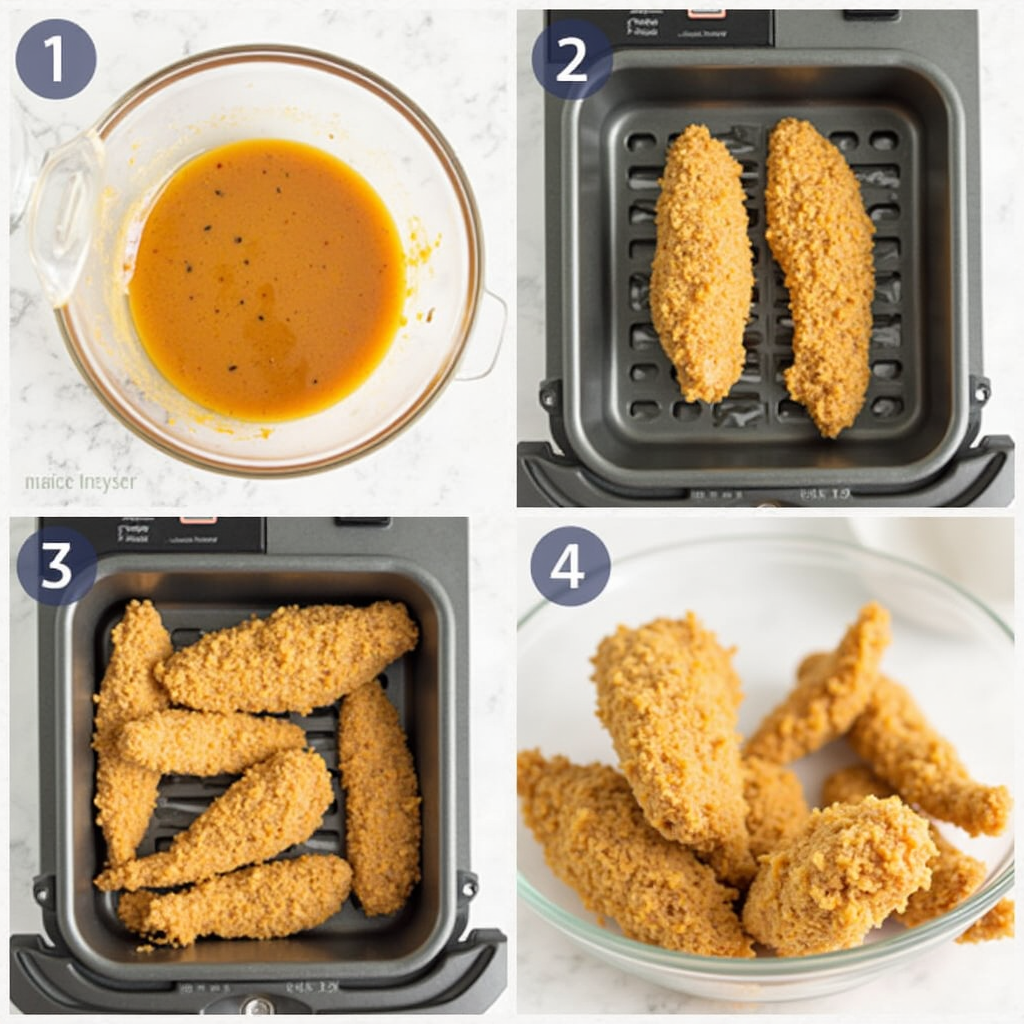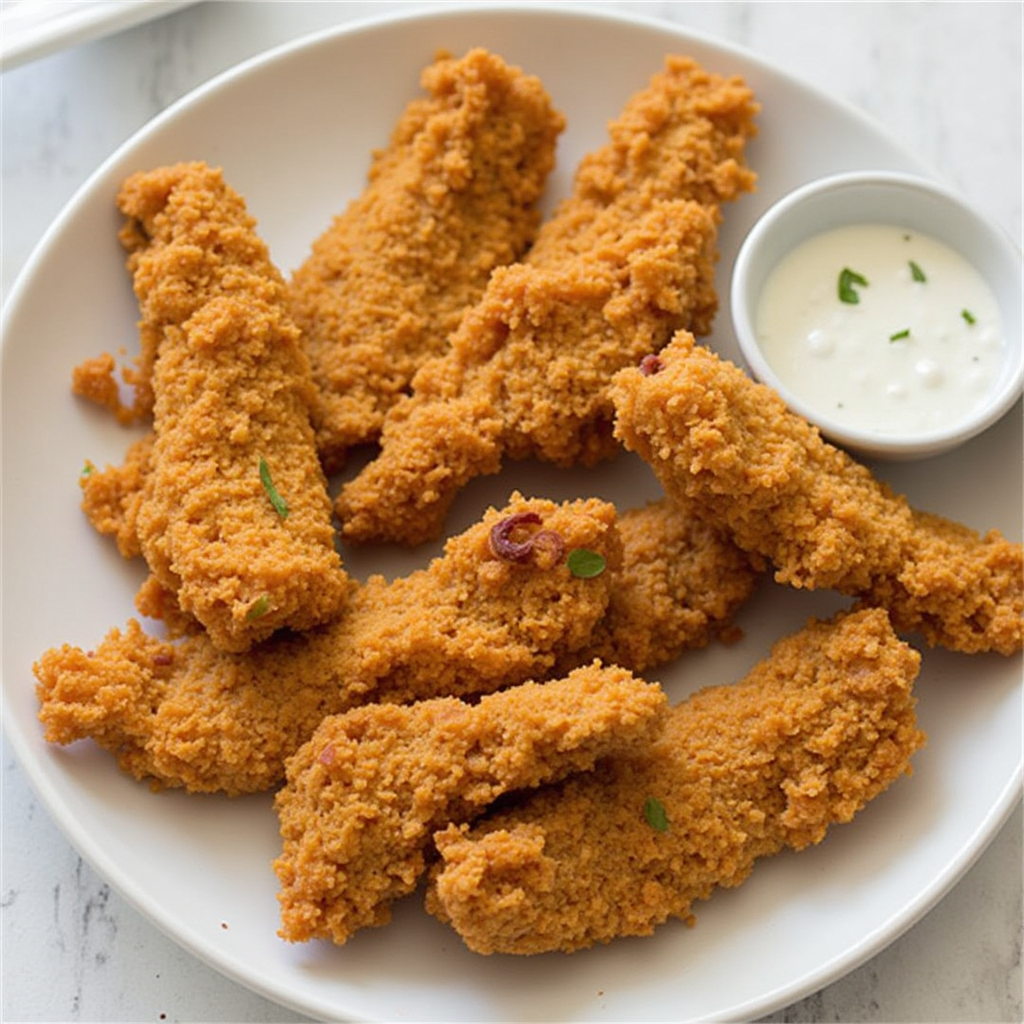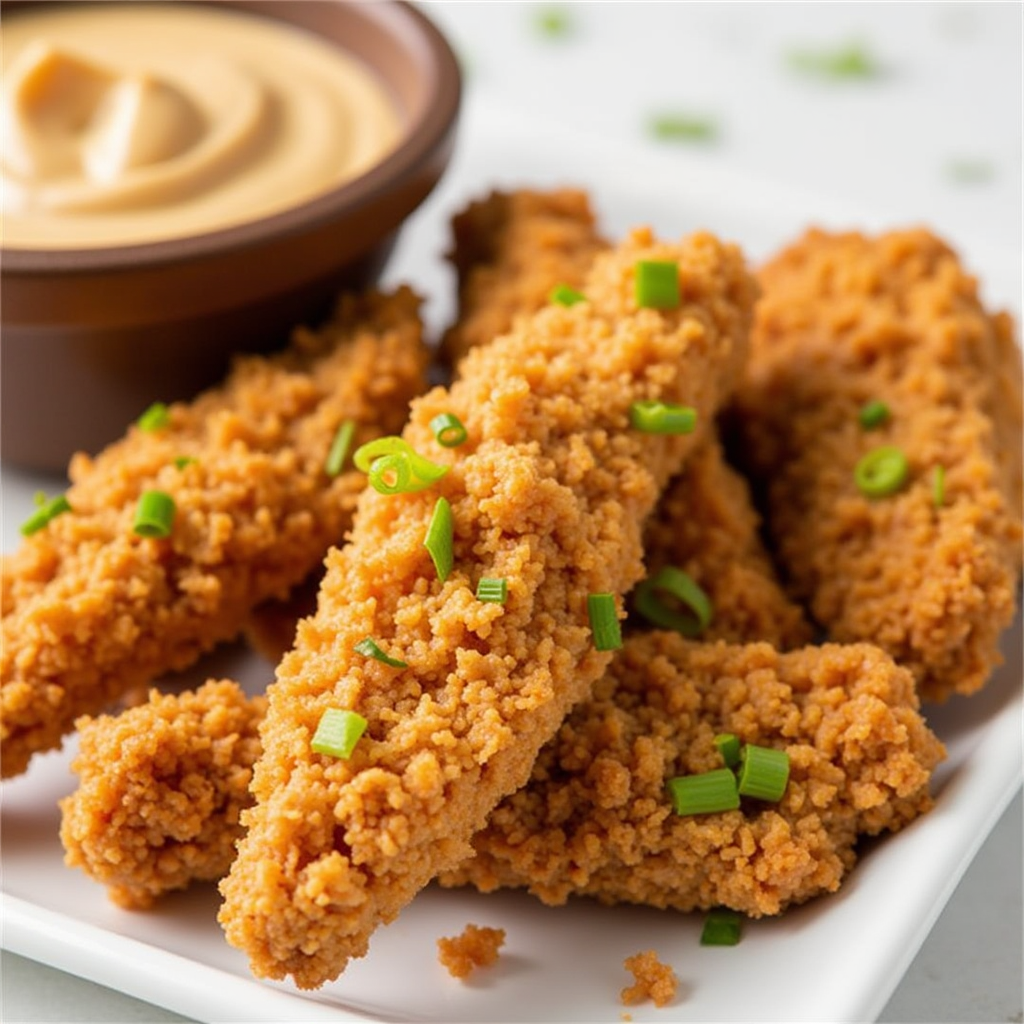Few dishes are as universally loved as crispy chicken strips. Whether served as a snack, appetizer, or main course, their crunchy exterior and juicy interior make them irresistible. Achieving the perfect balance of texture and flavor requires more than just frying chicken—it involves selecting the right cut, mastering marinades, and understanding cooking techniques.
With countless variations across cultures, crispy chicken strips remain a staple in many cuisines. Some prefer them mildly seasoned, while others enjoy bold flavors infused through marinades and spices. This article provides an in-depth look at what makes crispy chicken strips exceptional, covering essential ingredients, cooking methods, and expert techniques. By the end, you’ll have the knowledge to prepare restaurant-quality crispy chicken strips in your own kitchen.
History of Chicken Strips
The origins of crispy chicken strips trace back to the early 20th century, though battered and fried poultry has existed for centuries. Fried chicken itself gained popularity in the American South, influenced by European and African cooking traditions. Over time, chefs experimented with smaller, boneless cuts, leading to the creation of what we now recognize as crispy chicken strips.
By the 1970s, fast-food chains introduced crispy chicken strips to their menus, making them a convenient option for consumers seeking a quick yet satisfying meal. Their popularity soared as people appreciated the combination of a crunchy coating and tender meat. Today, they appear in various cuisines, from classic Southern-style to Asian-inspired versions featuring soy-based marinades and sesame crusts.
Restaurants and home cooks alike continue to refine the recipe, using different breading techniques and cooking methods. Whether fried or baked, crispy chicken strips remain a favorite among food enthusiasts worldwide.
Key Ingredients for Perfect Chicken Strips

The secret to making exceptional chicken strips lies in high-quality ingredients. Choosing the right combination ensures the perfect balance of taste and texture.
- Chicken: Boneless, skinless chicken breasts or tenderloins work best, offering a juicy interior.
- Flour: Provides structure to the breading, ensuring an even coating.
- Cornstarch: Enhances crispiness by reducing gluten formation in the coating.
- Eggs: Help bind the breading to the chicken for a uniform crust.
- Seasonings: A mix of salt, pepper, garlic powder, and paprika enhances flavor.
- Breadcrumbs or Panko: Regular breadcrumbs create a fine coating, while panko results in a crunchier texture.
- Oil: Neutral oils like vegetable or peanut oil are ideal for frying due to their high smoke points.
Using these ingredients in the right proportions guarantees crispy chicken strips with a golden, crunchy exterior and a juicy, flavorful interior.
Choosing the Best Chicken Cuts
Selecting the right cut of chicken significantly impacts the final texture of crispy chicken strips. While any boneless chicken can be used, certain cuts yield better results.
- Chicken Breast: The most common choice, offering a lean yet tender texture. It requires proper marination to prevent dryness.
- Chicken Tenderloins: Naturally softer and juicier, making them ideal for crispy chicken strips. They cook faster and retain moisture well.
- Thighs (Boneless & Skinless): While less common, they provide rich flavor and a slightly more succulent bite.
When preparing crispy chicken strips, cutting uniform pieces ensures even cooking. Strips that are too thick may remain undercooked inside, while overly thin pieces can become dry. Consistent sizing is key to achieving perfect results.
The Science Behind a Crispy Coating
Achieving the signature crunch of chicken strips requires a deep understanding of food science. The right combination of ingredients and cooking techniques ensures a golden, shatteringly crisp exterior.
- Moisture Management: Coating the chicken in flour before dipping it in egg wash helps absorb excess surface moisture, allowing the breading to adhere properly.
- Double Coating: Applying two layers of breading creates a thicker crust, intensifying crunchiness.
- Cornstarch Addition: Combining cornstarch with flour reduces gluten formation, preventing a tough, chewy texture.
- Oil Temperature: Frying at the optimal temperature (350-375°F) allows the exterior to crisp up without overcooking the interior.
Understanding these scientific principles ensures that every bite of crispy chicken strips delivers the perfect contrast of crunch and tenderness.
Best Marinades for Flavorful Chicken
While a great coating provides texture, marination ensures crispy chicken strips are bursting with flavor. The right marinade penetrates the meat, making it tender and juicy.
Popular marinade options include:
- Buttermilk Marinade: The acidity in buttermilk breaks down proteins, resulting in incredibly tender crispy chicken strips.
- Soy Sauce-Based Marinade: A combination of soy sauce, garlic, and ginger infuses an umami-rich depth of flavor.
- Spiced Yogurt Marinade: Yogurt’s natural enzymes tenderize the chicken while adding a subtle tang.
- Citrus & Herb Marinade: Lemon or lime juice combined with fresh herbs enhances brightness.
For the best results, marinate crispy chicken strips for at least two hours, though overnight marination yields the most flavorful outcome.
Perfect Breading Techniques
A well-executed breading process is essential for ensuring that crispy chicken strips develop a golden, crunchy exterior. The right technique prevents the coating from falling off while frying.
Follow these steps for flawless breading:
- Pat the Chicken Dry: Excess moisture prevents the breading from adhering properly.
- Dredge in Flour: A light dusting of seasoned flour creates a dry surface for the egg wash to cling to.
- Dip in Egg Wash: Beaten eggs help bind the outer coating to the chicken.
- Coat in Breadcrumbs or Panko: Press firmly to ensure the breading adheres evenly.
- Rest Before Cooking: Allowing the coated chicken to sit for 10-15 minutes helps the breading set.
By following this technique, chicken strips develop a crunchy, well-adhered crust that remains intact during frying or baking.
Deep Frying vs. Air Frying
Both deep frying and air frying produce crispy chicken strips, but they differ in texture, flavor, and overall cooking process.
Deep Frying
- Produces the crispiest exterior due to full oil immersion.
- Requires maintaining oil temperature between 350-375°F.
- Absorbs some oil, contributing to a richer flavor.
- Faster cooking time (approximately 5-7 minutes).
Air Frying
- Uses significantly less oil, making it a healthier alternative.
- Cooks with hot air circulation, achieving a moderately crispy texture.
- Requires a light spray of oil on the breaded chicken for optimal results.
- Slightly longer cooking time (12-15 minutes at 400°F).
For those seeking an indulgent crunch, deep frying is the preferred method. However, air frying offers a guilt-free way to enjoy crispy chicken strips without compromising too much on texture.
Oven-Baked Chicken Strips: A Healthier Alternative

For those looking to enjoy crispy chicken strips without the added oil from deep frying, baking provides an excellent alternative. With the right techniques, oven-baked versions can achieve a satisfying crunch while maintaining a juicy interior.
Tips for Perfect Oven-Baked Crispy Chicken Strips
- Use Panko Breadcrumbs: Their light, airy texture promotes better crispiness.
- Preheat the Baking Sheet: Placing the strips on a hot surface ensures an evenly browned crust.
- Lightly Coat with Oil: A light drizzle or spray of oil helps create a golden finish.
- Bake at High Temperature: Cooking at 400°F ensures a crisp exterior while keeping the inside tender.
- Use a Wire Rack: Elevating the strips allows air circulation, preventing a soggy bottom.
While oven-baked chicken strips may not have the same deep-fried crunch, they offer a healthier option without sacrificing flavor or texture. Pairing them with flavorful dips enhances their appeal even further.
Best Oils for Frying Chicken Strips
Choosing the right oil significantly impacts the texture and taste of crispy chicken strips. The ideal oil should have a high smoke point to prevent burning while delivering a golden, crispy exterior.
Top Oils for Frying
- Peanut Oil: A favorite for frying due to its high smoke point (450°F) and neutral flavor.
- Canola Oil: Affordable and widely available, it provides a mild taste and a smoke point of 400°F.
- Vegetable Oil: A versatile option, though it varies in quality depending on the blend.
- Sunflower Oil: Produces an extra crispy texture while maintaining a clean flavor.
- Avocado Oil: A healthier choice with a smoke point of 520°F, though more expensive.
Avoid using butter or olive oil for frying crispy chicken strips, as they burn at lower temperatures, resulting in an unpleasant taste. Maintaining the correct frying temperature ensures a crisp, evenly cooked coating without excessive oil absorption.
Serving Suggestions & Dipping Sauces
A plate of crispy chicken strips is only complete when paired with complementary sides and dipping sauces. The right accompaniments enhance the flavor while providing variety to each bite.
Popular Side Dishes
- French Fries: A classic pairing that balances crunch with a soft interior.
- Coleslaw: The creamy texture and tangy flavor provide a refreshing contrast.
- Mac & Cheese: A comforting, cheesy side dish that complements the crispy texture.
- Side Salad: A lighter option that adds freshness to the meal.
Best Dipping Sauces
- Honey Mustard: A perfect balance of sweetness and tanginess.
- BBQ Sauce: Adds a smoky, slightly sweet depth to crispy chicken strips.
- Buffalo Sauce: For those who enjoy a spicy kick.
- Garlic Aioli: A creamy, garlicky dip that enhances the flavors.
- Ranch Dressing: A crowd-pleaser with its cool, herby notes.
Pairing crispy chicken strips with the right sides and sauces elevates the dining experience, offering endless possibilities for flavor combinations.
Common Mistakes to Avoid
Even seasoned cooks can encounter issues when preparing crispy chicken strips. Understanding common mistakes helps ensure consistent, high-quality results.
Frequent Errors & How to Fix Them
- Overcrowding the Pan: Cooking too many strips at once lowers the oil temperature, leading to a greasy coating. Fry in small batches for even crispiness.
- Skipping the Resting Time: Letting the breaded chicken rest before cooking allows the coating to adhere properly, preventing it from falling off.
- Using Cold Chicken: Room-temperature chicken cooks more evenly and prevents the exterior from burning before the inside is done.
- Not Monitoring Oil Temperature: If the oil is too hot, the coating burns before the chicken cooks through. If too cold, the strips absorb excess oil, making them greasy.
- Baking Without a Wire Rack: Placing chicken strips directly on a baking sheet can lead to sogginess. Elevate them on a rack for better airflow.
By avoiding these mistakes, you can achieve consistently delicious, perfectly crispy results every time.
Storing & Reheating Chicken Strips
Proper storage and reheating techniques ensure that leftover crispy chicken strips retain their texture and flavor. When done correctly, they can be just as enjoyable as when freshly made.
How to Store
- Refrigeration: Store leftover crispy chicken strips in an airtight container for up to three days.
- Freezing: For longer storage, place strips on a baking sheet to freeze individually before transferring them to a freezer-safe bag. They last up to three months.
Best Reheating Methods
- Oven (Best for Crispiness): Bake at 375°F for 10-15 minutes to restore the crunch.
- Air Fryer: Reheat at 350°F for 5-7 minutes for a crispy exterior.
- Skillet: Heat on medium with a small amount of oil for a freshly fried texture.
- Microwave (Least Recommended): While convenient, microwaving makes the coating soft and rubbery.
Using the right reheating method ensures that chicken strips remain flavorful and crunchy, even after storage.
Frequently Asked Questions (FAQs)

1. Can I make crispy chicken strips gluten-free?
Yes, substitute all-purpose flour with a gluten-free blend and use crushed rice cereal or gluten-free breadcrumbs for the coating.
2. How do I make extra crispy chicken strips?
Use a double-coating method by dipping the chicken twice in the flour and breadcrumb mixture. Adding cornstarch to the flour also enhances crispiness.
3. What’s the best way to prevent breading from falling off?
Ensure the chicken is dry before breading, press the coating firmly, and let the breaded chicken rest for 10-15 minutes before frying.
4. Can I bake chicken strips instead of frying them?
Yes, baking at 400°F on a wire rack with a light oil coating produces a crispy texture without deep frying.
5. How do I know when crispy chicken strips are fully cooked?
Use a meat thermometer to check that the internal temperature reaches 165°F. The exterior should be golden brown and crunchy.
These FAQs address common concerns, ensuring that home cooks can confidently prepare crispy chicken strips with success.
Conclusion
Making perfect crispy chicken strips requires the right ingredients, proper techniques, and an understanding of cooking methods. Whether fried, baked, or air-fried, these golden, crunchy delights remain a favorite among food lovers of all ages.
By mastering marinades, breading methods, and frying techniques, you can create a version that rivals restaurant-quality crispy chicken strips. Paired with delicious sides and dipping sauces, they make a satisfying meal for any occasion. With this guide, you now have all the tools to achieve the perfect balance of crispiness and flavor—every time.

